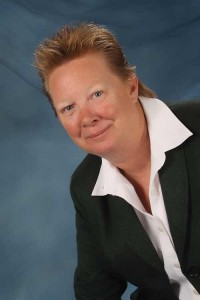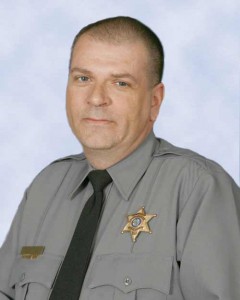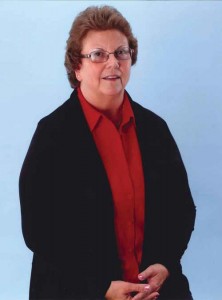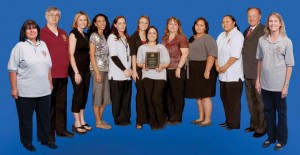APCO’s 2011 Award Winners
Over the years, APCO International’s Public Safety Communications Award Program has honored some of the best and brightest professionals serving the public safety communications industry across the U.S. This year is no exception. In fact, the program has grown with the addition of the Team Award, which acknowledges how an exceptional group of individuals can work together as a cohesive unit to serve the greater good.
The public safety community and APCO President Bill Carrow are grateful for the “hard work and diligence [these individuals have for] their active pursuit of excellence in their careers, for their communications center and within the realm of public safety.” APCO’s 2011 winners are:
Comm Center Director of the Year
After 30 years in public safety communications, Robin Schmidt has worked her way through the ranks to become communications division manager of Palm Beach County (Fla.) Sheriff’s Office (PBSO) and this year’s Comm Center Director of the Year. In her 26 years with the department, she has served as a telecommunicator, supervisor, CAD/GIS manager and acting manager. She also served for four years as an assistant manager for the West Palm Beach Police Department Communications Section.
Overseeing 150 employees, Schmidt ensures the efficient operation of all the employees and units under her supervision. From monitoring 9-1-1 and radio operations to schedules and workflow and managing the budget, she “wears many hats and is an expert at multitasking,” says Mark Gish, PBSO section supervisor.
As a manager, Schmidt cares about her employees. She is known for identifying their strengths and providing them with opportunities to use those strengths to benefit the agency. She also works to improve the conditions her staff works in. She recognizes individuals through promotions, established a permanent break room and regularly solicits staff input.
Schmidt “addresses employee concerns, and she is the motivating force in promoting the idea of ‘communications as a family,’” says Gish. “She is able to approach her duties and assignments with a communications officer’s viewpoint, thereby demonstrating her ability to quickly determine how management decisions or operational directives will affect her staff. She is willing to make adjustments in the best interests of the communications officers while providing needed services.”
Schmidt has also been willing to take on tough projects, working on new CAD and phone system implementations, comm center consolidations, training initiatives and testing for communications officer certification. She currently serves as team leader of CAD Core for the Multi Agency Network and Technology Applications project, an agencywide initiative designed to improve technology.
An advocate for 9-1-1 personnel, Schmidt founded the Telecommunicator Assistance Fund (TAF), a nonprofit organization designed to raise awareness about the individuals who answer 9-1-1 calls. TAF provides financial assistance to telecommunicators in need.
During National Public Safety Telecommunications Week (NPSTW), Schmidt organizes such annual events as bowling to raise money. Also during NPSTW, she works with staff to cook for and serve meals to all shifts.
Schmidt is active in Florida’s communications community and local APCO chapter. She has been involved in the creation of Florida’s new mandatory training and certification for telecommunicators, serving on the Florida Department of Education Communications Work Group. She also worked with the Florida APCO Chapter Training and the Palm Beach County Telecommunicator Training committees.
She serves as Southeast regional coordinator for APCO Florida’s State Disaster team, and has established a Communications Special Response Team, comprising volunteer telecommunicators who can assist other PSAPs 24/7 after major incidents. After Hurricane Andrew in 1992, Schmidt coordinated and supervised a group of PBSO communications officers and Palm Beach County fire rescue dispatchers who spent 10 days working in the Miami-Dade area during the aftermath. After Hurricane Katrina in 2005, she organized donations of food and personal hygiene items, loaded the items into a van and led a caravan of volunteers to deliver the supplies to comm centers in Alabama.
“Schmidt personifies professionalism and dedication in her position as PBSO’s Communications Division manager,” says Gish. “She strives for excellence and outstanding work practices while inspiring others to do the same. … Robin’s membership on various committees, along with her philanthropic work for the betterment of telecommunicators everywhere, often necessitate long hours away from home and more hours occupied with paperwork on the weekends. Schmidt not only works in the field of telecommunications, she lives and breathes it.”
Line Supervisor of the Year
Described as having a drive and passion for serving the mission of public safety communications, Shayl McCormick, a supervisor for the city of Tucson (Ariz.) General Services Communications Division, is this year’s Line Supervisor of the Year.
Throughout her 10-year communications career, McCormick served as a telecommunicator, a trainer for six years and, now, a supervisor for the past three. She has translated her love of learning into a benefit for her staff through her innate ability to coach and mentor employees, ensuring their personal success on the job.
McCormick “has served as a catalyst for training improvements, morale and team-building functions,” says Jim Long, communications coordinator, Northwest Fire District. “I don’t know how many employees have come to me and said, ‘If it wasn’t for the time [McCormick] spent with me, coaching and teaching, I probably wouldn’t have made it.’ … Her zeal does not cause her to lose patience or empathy for others. … [She] exudes a calming influence and is able to effectively coach and mentor employees with learning barriers, and inspires rather than coerces performance.”
For McCormick, it all comes back to service. According to Long, leadership is “making the decision to make a difference and about serving others rather than having others serve you.” She has stepped up when the agency has been short supervisory staff, reorganizing schedules and working to find a balance that would meet everyone’s needs. When employees were unsatisfied with a change to the break policy, McCormick created an employee survey and worked to implement changes, resulting in a more effective policy that improved the team atmosphere.
In addition to her duties on the operations floor, McCormick handles all complaints filed by the public against communications staff in a manner that benefits the agency and the community. Taking the approach that a complaint is an opportunity to learn and improve, she is thorough in her investigations, yet sensitive. She provides citizens with the education they need if a complaint results from a misunderstanding of policy. If the complaint is founded, she provides the employee with coaching and support.
McCormick has also served as an interagency liaison for many years, participating in in-field training exercises and building a better report between the comm center and field personnel. As a result, she has earned the respect of fire chiefs and captains, police lieutenants and local PSAP managers.
Her leadership ability and belief in serving others truly shined when a lone gunman opened fire outside a Tucson shopping center earlier this year.
Jan. 8: McCormick was the supervisor on duty when a gunman attempted to kill Rep. Gabby Gifford, wounding 13 people and killing six. The agency’s primary and secondary PSAPs began to receive overflow calls from the Pima County Sheriff’s Office. McCormick remained calm and began answering calls. As soon as the incident’s magnitude was known, she alerted local hospitals.
She also took care of her dispatchers. When it became clear that the dispatcher working the police hotline and the tactical response channel knew one of the victims, McCormick helped “stabilize the dispatcher through her own focus on the mission at hand and professionalism,” says Long. She also modified the workflow to give that dispatcher a break, and contacted CISM to arrange support and post-incident care for the team.
“It has been unanimously mentioned by all of the dispatchers on duty, that they would have [fallen] to pieces without their leader that day,” says Long. “[Her] job knowledge, skills, confidence and inspirational leadership abilities helped the center handle one of the largest medical incidents in the last decade and saved lives.”
Telecommunicator of the Year
“Richard Garman handles each incident with confidence and just the right personal touch to put the caller at ease, let them know help is on the way and defuse the situation at hand,” says Grays Harbor Communications E9-1-1 Director Peggy Fouts. “When things go sideways, Richard is the voice the field units want to hear on the radio.”
Garman, senior telecommunicator for Grays Harbor Communications E9-1-1 in Aberdeen, Wash., is Telecommunicator of the Year. A former U.S. Air Force veteran, he joined the agency in 1997 and was promoted to his current position in 2007.
Described as a master of the agency CAD system and able to remain calm and “unruffled” during difficult calls, Garman’s performance extends beyond the console. He provides oversight, direction and support to other personnel on duty; writes extensive and insightful telecommunicator evaluations; and is responsible for updating the CAD system.
Garman is known for his ability to support and assist his co-workers and field units using a calm manner that also demonstrates his confidence in their ability.
Garman “understands and applies the concepts behind servant leadership,” says Fouts. “[He] is conscientious about doing what is right and being sensitive to the needs and concerns of his co-workers. Richard recognizes the importance of trust and cooperation.”
“The geo-god:” Garman also developed and maintains the mapping system. He taught himself Altaris GDI, and Northrop Grumman invited him to its headquarters to beta test the new program prior to implementation. He continues to provide the company with feedback on performance and programming issues.
Garman “is not a single-faceted employee,” says Fouts. “He displays equal competence at any task he chooses to take on, whether it be developing policies and procedures, overseeing a busy dispatch room or working a dispatch console. … In addition, [he] has the ability to keep his fingers on the pulse of a dispatch team.”
Recently, Garman was asked to serve on the Homeland Security Region 3 GIS mapping committee, which is developing a system that will serve three counties.
At the console or serving in a technical manner, Garman “promotes teamwork, a positive attitude and fun on his shifts, while at the same time setting and adhering to strong standards of professionalism,” says Fouts.
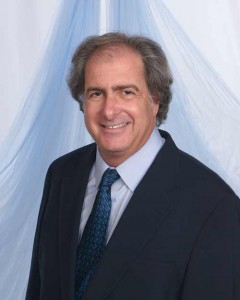
Peter K. Loewenheim, communications maintenance manager, Washington County (Md.) Communications Maintenance
Radio Frequency Technologist of the Year
Peter K. Loewenheim is communications maintenance manager and communications system upgrade project manager for Washington County (Md.) Communications Maintenance and is Radio Frequency Technologist of the Year.
In April 1980, Loewenheim joined the division as a technician and has since advanced through the ranks. He oversees equipment for six law enforcement agencies, 25 fire stations and eight EMS stations, as well as the primary and backup PSAPs. He is involved with the design, purchase, installation and maintenance of all these systems.
Over the years, Loewenheim has worked closely with the public safety agencies he serves. He meets with various vendors to work through licensing and frequency issues. In 2006, Loewenheim was appointed project manager of the Washington County Public Safety Radio Committee (on which he served as chair) for the design and implementation of a digital trunked public safety and local government communications system. During the implementation, he and other technicians saved the county millions by installing all the equipment.
He also responds to pages for assistance from communications personnel and participates in radio system training.
According to Bardona Woods, Washington County Communications director, “Since the use of the trunked radio system began, [he] has sacrificed countless hours of personal time responding to frequent pages, phone calls, and e-mails from dispatch, fire, EMS, and law enforcement personnel, seeking advice and resolution to issues from our radio system vendors.”
Loewenheim is flexible when it comes to the job, scheduling and rescheduling system maintenance and upgrades for times that work best for the comm center. He works tower maintenance and upgrades around bad weather and public opposition.
Woods says, “Multiple times, [he] has had to reschedule his personal vacation and holidays in order to meet communications system deadlines. … The most evident example of how Loewenheim goes above and beyond what is required of him is that he has been eligible for retirement for a few years, but refuses to retire until this project is complete.”
Information Technologist of the Year
After 14 years as a telecommunicator and supervisor on the comm center floor, Robert W. Jeffrey, this year’s Information Technologist of the Year, was tapped for his current position as systems supervisor for the Orange County (Fla.) Sheriff’s Office in 2007. His position is designed to bridge the gap between the technician and the telecommunicator.
“Jeffrey is a telecommunicator who is also very versed in computers and technology (most of it self taught),” says Amy L. Campbell, assistant director of Emergency Communications. “[He] has always been very familiar with all the equipment in the Communications Center and was a natural for this position. … [He] has shown time and time again that his knowledge of the systems within Communications far exceeds that of most anyone.”
In his role, Jeffrey assists the Information Management Section with monthly CAD updates, acts as a liaison between the agency and its technology vendors, troubleshoots systems and computers. He is also actively involved in evaluating new communications technology and systems, as well as instructing trainees on how to use the agency’s current systems. He manages two staff members in the audio room and serves as liaison for the Public Defenders and State Attorney offices regarding 9-1-1 audio files.
In the audio room, Jeffrey oversaw the transition from tape recordings to CDs, training the audio specialists and reducing the time required to produce the files. He also created a digital BOLO process using the agency’s RMS, and serves on the committee that is redesigning the Agency Portal. Jeffrey will also serve as the vendor liaison for the agency’s emergency notification system after the upcoming public education campaign about the system.
Beyond his IT role, Jeffrey helps with hiring by serving on the interview selection board when needed. He is able to serve as a supervisor during critical incidents and staffing shortages. He also teaches classes on software and equipment operation.
Jeffrey actively helps his coworkers and betters the work environment. “Because Robert started his career in communications, he is aware of the responsibilities of each position and understands the importance of always having fully functional equipment and software,” says Campbell. “He is constantly looking for new and better ways to accomplish the various tasks that personnel face on a daily basis. As a supervisor, he can be counseling or coaching his personnel one minute and fixing a computer the next.”
Off duty: Jeffrey is currently president elect of the APCO Florida Chapter and one of two team leaders for the local Florida CERT (Communications Emergency Response Team). He also represented the department during the efforts of Florida’s public safety communications community to pass legislation for telecommunicator training and certification in 2008. As a result of his efforts, 136 department telecommunicators are currently certified. He also maintains a grammar blog, posting tips on the agency bulletin board.
Jeffrey is still learning. In 2009, he took classes and became an amateur radio operator, and this spring, he enrolled in the APCO Institute’s Leadership Certificate Program to become a Registered Public-Safety Leader.
“He is no longer a 9-1-1 calltaker or a dispatcher so he will never be recognized for his spectacular handling of a hostage situation or an active shooter; however, his job function is no less important and no less deserving of recognition,” says Campbell. “Without his daily assistance and support, our operation would not run as smoothly and efficiently as it does. His work ethic is unquestionable, and his pride in his work and his agency is evident.”
Trainer of the Year
Connie Felton, this year’s Trainer of the Year, has been one of the Lee Summit (Mo.) Police Department (LSPD) Communications Unit’s strongest communications training officers for nine years, says Caroline Rader, lead communications specialist for the department.
Felton has been with department for almost 13 years, but her career spans 26. Prior to joining LSPD, she was a calltaker and supervisor for the Kansas City Police Department. In 2002, she was promoted to lead communications specialist at LSPD, working with five other communications specialists on the day shift.
Felton has taken the initiative to research training and now oversees the department’s CTO program. She sets the standards for performance, as well as identifies, schedules and records all training mandates with the training coordinator.
“[Her] research and implementation into new training methods have engaged all personnel within the communications unit,” says Rader. “The completion of this training has ensured that our unit is compliant with APCO, NENA and CALEA standards.”
The department’s training program is 24 weeks long, and trainees are immediately placed at a console. Felton works with the comm center director to determine the best CTO for each new employee. She remains available for questions and guidance throughout the process.
As a trainer, Felton is tough, but is also the trainee’s greatest advocate. Rader says, “[She] requires her trainees to apply themselves and not to be fearful of the dreaded mistakes that are going to happen, learn from these and move on to the next. … [Felton] believes in the trainee and their capabilities.”
Felton headed a committee tasked with rewriting the communications procedure and training manuals. She is also knowledgeable about TTY/TDD and worked hard to organize the appropriate logs and bring the agency into compliance with TTY/TDD testing.
In 2010, she organized the department’s elementary school education program 9-1-1 for Kids, working with other LSPD communications specialists to teach school children about 9-1-1.
Felton is known for her always professional, yet straightforward, demeanor.
“Over the past 13 years, [Felton] has given selflessly to our unit. [She] is not afraid to work,” says Rader. “She is definitely one of the first to step up to the plate and volunteer to take on a project or a task. … [She] continues to strive at making our communications unit top in the area.”
Team of the Year
On the morning of Jan. 8, 2011, the day shift of the Pima County (Ariz.) Sheriff’s Department Comm Center performed exceptionally under pressure during the attempted assassination of Rep. Gabrielle Giffords. At 10 a.m., a single male opened fire on a crowd attending Gifford’s “Congress on Your Corner” meeting outside a grocery store, wounding 13 and killing six people.
The individuals honored with the inaugural Team Award are Tony Portrey, the supervisor on duty; Karen Bock, Beatrice Brito, Brittani Caudillo, Ramona Eason, Carla Miles, Jacqueline Montano, Cecilia Ochoa and Amanda Rosano, the 9-1-1 dispatchers on duty; and Lisa Robinson and Barbara Ward, the calltakers on duty.
Within three minutes, the three team members fielded 30 calls from people who had witnessed the shooting, were in the shopping center or were reporting shots fired. Robinson, a trainee with two months on the job, answered the first call. Ward, her trainer, allowed her to handle the voice part of the calls while entering information into the CAD system.
9-1-1 Dispatch Manager Pat Joy says, “It quickly became apparent that this was not a simple shooting call. Callers reported numerous victims, some severely injured. EMS dispatch was advised.”
Miles, who typically traffics 15 units on a Saturday, was trafficking 70, calmly communicating with and dispatching the responders. Meanwhile, Ochoa took on the task of handling the routine calls for service in the area, doubling her workload and ensuring no call was missed.
Caudillo, Eason and Brito reported to work after the incident was underway. When a deputy became involved in a fight with a suspect, resulting in an officer-needs-help broadcast, Caudillo handled the incident by the book and then started answering non-emergency calls with Bock as dispatch traffic allowed.
Montano served as relief dispatcher, answering 9-1-1 calls and providing breaks to other dispatchers. Around 10:30 a.m., Rosano was immersed in answering calls from people looking for information, and reporting those routine calls that make up most days in a comm center.
Joy says, “Ward and Robinson kept their cool and fielded a third of the 9-1-1 calls reporting the shooting. [Ward] allowed her trainee to gain valuable experience by not taking over any of the shooting calls. She assisted by doing CAD entry and encouraged Lisa if she seemed about to stumble.”
Running the show throughout the entire incident was Portrey, who handled many of the initial calls, including the call reporting that the suspect was restrained on the ground. When the calls slowed, Portrey began notifying command throughout the department and the Pima County Office of Emergency Management.
Portrey “supported all staff members, ensuring they were handling the situation well,” says Joy. “He also made sure they all knew he thought they were doing an outstanding job. … He was the core around which this team revolved to get the job done without losing sight of customer service, and officer and citizen safety.”
This team of professionals remained calm and composed, adapting quickly to what the incident presented. The intensity of the incident was magnified when it was discovered that Giffords was wounded. A fact that brought national attention to the agency. After the incident was resolved, requests for information kept coming in from the media, and the FBI and other federal law enforcement agencies.
“This was an incident that would try any dispatch team faced with working a mass shooting,” says Joy. “This team and how they responded to this horrific incident defines teamwork.”
Horizon Awards
The Horizon Awards recognize the technological advancements of comm centers across the nation with regard to voice and data communications, while acknowledging the efforts of centers that have proactively assessed and met the technological and operational needs of their employees and service population. The award is presented to one large and one small telecommunications center annually. This year’s recipients are the Salt Lake Valley Emergency Communications Center (VECC) and city of San Luis Obispo (Calif.) Communications Center.
VECC, which received the award for a larger center, created a robust in-house e-learning environment, enabling employees to engage in media-rich learning activities at their desks. The “e-learning campus,” VECC Online, is built on Claroline’s Open Source eLearning and eWorking platform. This framework launched in March 2008 and has become the largest method used for continued dispatch training.
The city of San Luis Obispo, which received the small-center award, built a technologically advanced comm center, highlighting dispatcher safety, security and personal needs. The center’s technology includes cat6 data cable and fiber wires, Clear Cube blade PC technology, AT&T Viper 9-1-1, Pano Virtual PCs, virtual server clusters, Spillman CAD, a text-to-voice fire station alerting system, a new Tait citywide emergency simulcast/digital radio system, and Russ Bassett console furniture. The project was led by an information technology team.
All awardees will be honored during the 77th APCO Annual Conference & Exposition in Philadelphia.
About the Author
Natasha Yetman is associate editor for APCO International’s Public Safety Communications. Contact her via e-mail at yetmann@apcointl.org.
Originally published in APCO International’s Public Safety Communications, Vol. 77(8):32-41, August 2011.

